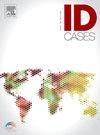Spontaneous rupture of a subcapsular hepatic hematoma due to fascioliasis: A rare parasitic complication managed conservatively – Case report
IF 1.1
Q4 INFECTIOUS DISEASES
引用次数: 0
Abstract
Background
Fascioliasis is a parasitic zoonosis endemic to South America, caused by Fasciola hepatica. During the acute migratory phase, the parasite affects the liver parenchyma, potentially leading to complications such as abscesses or necrosis. However, spontaneous rupture of a hepatic subcapsular hematoma related to Fasciola hepatica infection is exceptionally rare and poorly documented in the literature. The aim of the present study is to report an unusual presentation of Fasciola hepatica infection and to highlight the diagnostic relevance of parasitic etiologies in patients with eosinophilia and atypical hepatic imaging findings in endemic areas or in patients with travel history.
Case presentation
A 38-year-old man from a rural area endemic for Fasciola hepatica presented with progressive right upper quadrant abdominal pain, dizziness, and fatigue. Physical examination revealed pallor and localized tenderness. Laboratory studies showed severe normocytic anemia (hemoglobin: 6.8 g/dL) and marked eosinophilia (2600 cells/μL). Abdominal CT revealed a large subcapsular hepatic hematoma with hemoperitoneum. Given the eosinophilia and epidemiological background, a parasitic cause was suspected. Western blot serology confirmed Fasciola hepatica infection. Liver function tests were normal, and there was no history of trauma or coagulopathy. The patient received conservative management, including fluid resuscitation, blood transfusion, and antiparasitic treatment with triclabendazole (10 mg/kg, repeated after 12 h). Follow-up imaging demonstrated gradual hematoma resolution. He was discharged after 10 days in stable condition and remained asymptomatic during outpatient follow-up.
Conclusion
This case underscores the need to consider parasitic infections in the differential diagnosis of unexplained hepatic lesions with eosinophilia, especially in endemic areas. Early recognition enables effective non-surgical management.
片形吸虫病引起的肝包膜下血肿自发性破裂:一种罕见的寄生虫并发症-病例报告
片形吸虫病是南美洲特有的一种寄生虫人畜共患病,由肝片形吸虫病引起。在急性迁移期,寄生虫影响肝实质,可能导致脓肿或坏死等并发症。然而,与肝片形吸虫感染有关的肝包膜下血肿自发性破裂是非常罕见的,文献记载很少。本研究的目的是报告一种不寻常的肝片吸虫感染的表现,并强调寄生虫病因在嗜酸性粒细胞增多患者和流行地区或有旅行史的患者中的非典型肝脏影像学表现的诊断相关性。病例表现:一名38岁的农村肝炎片形吸虫患者,以进行性右上腹腹痛、头晕和疲劳表现。体格检查显示苍白和局部压痛。实验室检查显示严重的正红细胞性贫血(血红蛋白:6.8 g/dL)和明显的嗜酸性粒细胞增多(2600个细胞/μL)。腹部CT显示大的肝包膜下血肿伴腹膜出血。考虑到嗜酸性粒细胞增多和流行病学背景,怀疑是寄生虫引起的。免疫印迹血清学证实肝片形吸虫感染。肝功能检查正常,无外伤或凝血功能障碍史。患者接受保守治疗,包括液体复苏、输血和三氯咪唑抗寄生虫治疗(10 mg/kg, 12 h后重复)。随访影像显示血肿逐渐消退。10天后出院,病情稳定,门诊随访无症状。结论本病例强调了在病因不明的肝病变伴嗜酸性粒细胞增多的鉴别诊断中需要考虑寄生虫感染,特别是在流行地区。早期识别有助于有效的非手术治疗。
本文章由计算机程序翻译,如有差异,请以英文原文为准。
求助全文
约1分钟内获得全文
求助全文

 求助内容:
求助内容: 应助结果提醒方式:
应助结果提醒方式:


